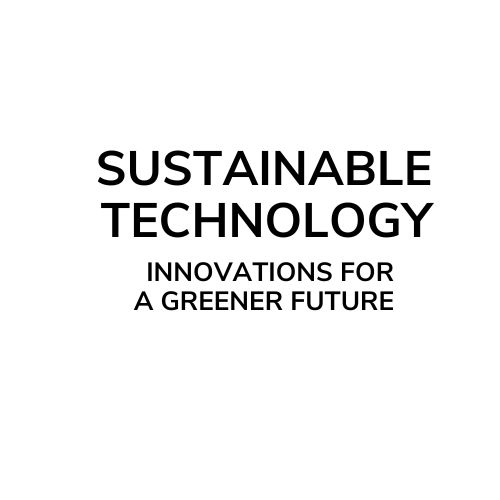Sustainable Technology: Innovations for a Greener Future

Sustainable technology plays a pivotal role in creating a greener future by addressing environmental challenges and promoting eco-friendly practices across various industries. Here are some key innovations and technologies contributing to a more sustainable world:
- Renewable Energy Sources:
- Solar Power: Advancements in photovoltaic technology have made solar panels more efficient and cost-effective, enabling widespread adoption of solar energy.
- Wind Power: Innovative turbine designs and improved efficiency in harnessing wind energy have expanded the use of wind power globally.
- Hydroelectric Power: Upgrades in hydroelectric technology and the development of smaller-scale hydro systems enhance the generation of clean energy.
- Energy Storage Solutions:
- Battery Technology: Advances in battery storage, such as lithium-ion batteries and emerging technologies like solid-state batteries, are crucial for storing renewable energy and powering electric vehicles.
- Grid-Scale Energy Storage: Solutions like pumped hydro storage, flywheels, and compressed air energy storage help stabilize power grids by storing excess renewable energy for later use.
- Green Building Materials and Design:
- Sustainable Construction: Utilizing eco-friendly materials like recycled steel, bamboo, reclaimed wood, and energy-efficient designs, such as passive houses, reduces environmental impact and promotes energy conservation in buildings.
- Green Infrastructure: Implementation of green roofs, permeable pavements, and rainwater harvesting systems in urban planning helps manage stormwater, reduce heat islands, and improve air quality.
- Circular Economy and Waste Management:
- Recycling Innovations: Advanced recycling technologies enable the efficient reprocessing of materials, including plastics, metals, and electronic waste, to reduce landfill waste.
- Waste-to-Energy: Technologies like anaerobic digestion, pyrolysis, and gasification convert organic waste into biogas, biofuels, or electricity while minimizing greenhouse gas emissions.
- Sustainable Transportation:
- Electric Vehicles (EVs): Continued advancements in EV technology, including longer battery life, faster charging, and increased vehicle range, contribute to reducing reliance on fossil fuels and curbing emissions.
- Public Transit Innovations: Development of efficient, low-emission public transportation systems like electric buses, light rail, and high-speed trains promotes sustainable mobility.
- Precision Agriculture and Food Systems:
- Smart Farming: Integration of IoT devices, drones, and data analytics in agriculture optimizes resource use, minimizes water and pesticide usage, and enhances crop yield while reducing environmental impact.
- Plant-Based Alternatives: Innovations in plant-based proteins, lab-grown meats, and alternative food sources aim to reduce the environmental footprint of the food industry and promote sustainable diets.
These sustainable technology innovations showcase the potential for creating a greener future by reducing carbon emissions, conserving natural resources, and fostering a more environmentally conscious society.
8 Sustainability ideas that will change the world
Tools of Sustainable Technology: Innovations for a Greener Future
Tools and innovations in sustainable technology encompass a wide range of solutions aimed at promoting environmental conservation, reducing carbon footprints, and fostering a more sustainable future. Here are some key tools and technologies contributing to a greener world:
- Smart Grids and Energy Management Systems: These systems optimize energy distribution, allowing for better integration of renewable energy sources, demand-side management, and efficient energy use. Smart meters, sensors, and real-time data analytics help in monitoring and managing energy consumption.
- Energy-Efficient Appliances and Devices: Innovation in the design and development of energy-saving appliances like refrigerators, air conditioners, LED lighting, and smart thermostats significantly reduces energy consumption in households and businesses.
- Clean Energy Generation Technologies: Advancements in solar panels, wind turbines, hydroelectric power, geothermal systems, and tidal energy technologies enable the generation of renewable energy with minimal environmental impact.
- Battery and Energy Storage Solutions: Improved battery technologies such as lithium-ion batteries, flow batteries, and solid-state batteries facilitate efficient energy storage, enabling better utilization of intermittent renewable energy sources and supporting grid stability.
- Green Building Materials and Techniques: Sustainable construction materials like recycled steel, bamboo, rammed earth, and innovative insulation materials reduce the environmental impact of buildings. Techniques such as passive design, green roofs, and efficient HVAC systems promote energy efficiency.
- Water Conservation and Management Tools: Technologies such as smart irrigation systems, water-efficient fixtures, rainwater harvesting systems, and water recycling technologies help conserve and manage water resources in agriculture, industries, and households.
- Waste Management and Recycling Innovations: Advanced recycling technologies for plastics, metals, paper, and electronic waste minimize waste going to landfills. Waste-to-energy technologies, composting, and anaerobic digestion convert organic waste into useful products and energy.
- Transportation Innovations: Electric vehicles (EVs), hybrid cars, hydrogen fuel-cell vehicles, and advancements in public transportation systems like electric buses and high-speed trains reduce reliance on fossil fuels and cut down emissions.
- Precision Agriculture and Sustainable Farming Tools: IoT-enabled devices, drones, AI-based analytics, and precision farming tools optimize resource use in agriculture, reducing water consumption, pesticide use, and enhancing crop yields sustainably.
- Environmental Monitoring and Data Analytics: Remote sensing technologies, satellite imagery, and sophisticated data analytics help in monitoring and managing environmental changes, allowing for better decision-making and policy implementation.
These tools and innovations in sustainable technology collectively contribute to mitigating climate change, reducing environmental degradation, and fostering a more sustainable and eco-friendly future for generations to come.
Advantages of Sustainable Technology: Innovations for a Greener Future
Sustainable technology offers a multitude of advantages that contribute to creating a greener future and addressing pressing environmental challenges. Here are some key advantages:
- Reduced Environmental Impact: Sustainable technologies prioritize the use of renewable resources, minimize waste generation, and decrease pollution levels. They help in curbing greenhouse gas emissions, protecting biodiversity, and preserving ecosystems, thus mitigating the adverse effects of climate change and environmental degradation.
- Conservation of Natural Resources: By promoting efficient use of resources and reducing dependence on finite resources like fossil fuels, sustainable technologies help in conserving natural resources such as water, forests, minerals, and energy sources.
- Energy Efficiency and Cost Savings: Many sustainable technologies focus on energy efficiency, resulting in reduced energy consumption and operational costs for businesses and households. Energy-efficient appliances, buildings, transportation, and industrial processes not only lessen environmental impact but also lead to financial savings over time.
- Job Creation and Economic Growth: The transition to sustainable technologies fosters the growth of green industries, creating employment opportunities in sectors such as renewable energy, green construction, waste management, and clean transportation. It also encourages innovation and entrepreneurship, contributing to economic growth.
- Improved Public Health: Sustainable technologies, especially those reducing air and water pollution, have a positive impact on public health. Decreased emissions from cleaner energy sources and transportation systems lead to lower rates of respiratory diseases and other health issues associated with air pollution.
- Resilience and Adaptation to Climate Change: Sustainable technologies help communities adapt to the impacts of climate change by offering resilient solutions. This includes technologies for water management, renewable energy, sustainable agriculture, and infrastructure designed to withstand extreme weather events.
- Global Collaboration and Sustainability Goals: Sustainable technology encourages international collaboration and partnerships to achieve common sustainability goals outlined in agreements like the Paris Agreement or the Sustainable Development Goals (SDGs). It fosters cooperation among nations and industries to work towards a more sustainable future.
- Consumer Awareness and Consciousness: The adoption of sustainable technologies encourages a shift in consumer behavior towards more eco-conscious choices. As consumers become more aware of environmental impacts, they tend to support sustainable products and companies, thereby driving market demand for greener solutions.
- Long-Term Viability and Future Proofing: Sustainable technologies focus on long-term viability by minimizing the depletion of resources and reducing environmental harm. Investing in sustainable practices ensures resilience against future resource shortages and environmental crises.
- Positive Environmental Legacy: By embracing sustainable technologies, societies leave a positive environmental legacy for future generations. It sets the stage for a more sustainable and equitable world, ensuring that resources are available and ecosystems are preserved for the well-being of future populations.
The adoption and advancement of sustainable technologies play a crucial role in achieving a greener, more resilient, and equitable future for both the environment and society as a whole.
Disadvantages of Sustainable Technology: Innovations for a Greener Future
While sustainable technology brings numerous benefits, it also presents certain challenges and drawbacks that need consideration. Here are some disadvantages associated with sustainable technology:
- High Initial Costs: The implementation of sustainable technologies often requires significant upfront investments. For instance, installing renewable energy systems, energy-efficient appliances, or eco-friendly infrastructure may involve higher initial costs compared to conventional technologies, which could deter initial adoption.
- Technological Limitations and Development Challenges: Some sustainable technologies are still in the developmental stage or may have technological limitations. For instance, certain renewable energy sources like solar and wind power depend on weather conditions and require advancements in storage technologies for consistent energy supply.
- Intermittency and Reliability Issues: Renewable energy sources such as solar and wind power can be intermittent and variable, leading to challenges in maintaining a steady and reliable power supply. Energy storage technologies are needed to address these intermittency issues.
- Resource Intensiveness and Environmental Impacts: While aiming to reduce environmental impact, the production of certain sustainable technologies might require significant resources, including rare earth metals, minerals, and land use, leading to environmental impacts associated with extraction and manufacturing.
- Infrastructure and Retrofitting Challenges: Retrofitting existing infrastructure and industries to accommodate sustainable technologies can be logistically challenging and costly. Upgrading infrastructure to support electric vehicles, renewable energy integration into grids, or implementing sustainable building practices may require significant changes.
- Limited Scalability and Accessibility: Some sustainable technologies might face limitations in scalability or accessibility, especially in developing regions or remote areas where infrastructure for these technologies may be lacking or economically unfeasible to implement.
- Social and Economic Disparities: The transition to sustainable technologies can sometimes exacerbate social and economic disparities. Affordability barriers may restrict access to certain eco-friendly products or services, creating disparities between different socioeconomic groups.
- Potential for Greenwashing: In some cases, companies may exaggerate or misrepresent their products or practices as sustainable, engaging in “greenwashing” to capitalize on the growing demand for eco-friendly solutions without genuinely prioritizing sustainability.
- Dependency on Government Policies and Support: The adoption and success of sustainable technologies often rely on supportive policies, incentives, and regulations from governments. Uncertain policies or lack of consistent support may hinder the growth of sustainable technology industries.
- Skills and Training Requirements: Implementing and maintaining sustainable technologies may require specialized skills and training. A lack of trained personnel and workforce in these areas can pose challenges to the effective deployment and operation of sustainable solutions.
Understanding these disadvantages can guide efforts to address challenges and find innovative solutions to make sustainable technologies more accessible, cost-effective, and efficient in contributing to a greener future.
DHAMAAD
Hadii aad intaan soo gartay waad guulesatay, waxaan ku rajayna inaa maqaalkan/ article kan wax ka faidi doontid illah idinkiis, waxii su’aalo ah qeybta comment no ku reeb ama tobic aad jaceshahay inaa kaso hadalno Insha allah. THANK YOU YOUR VISIT.





